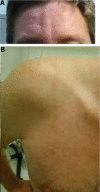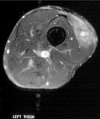Gnathostomiasis, another emerging imported disease
- PMID: 19597010
- PMCID: PMC2708391
- DOI: 10.1128/CMR.00003-09
Gnathostomiasis, another emerging imported disease
Abstract
Gnathostomiasis is a food-borne zoonosis caused by the late-third stage larvae of Gnathostoma spp. It is being seen with increasing frequency in countries where it is not endemic and should be regarded as another emerging imported disease. Previously, its foci of endemicity have been confined to Southeast Asia and Central and South America, but its geographical boundaries appear to be increasing, with recent reports of infection in tourists returning from southern Africa. It has a complex life cycle involving at least two intermediate hosts, with humans being accidental hosts in which the larvae cannot reach sexual maturity. The main risks for acquisition are consumption of raw or undercooked freshwater fish and geographical exposure. Infection results in initial nonspecific symptoms followed by cutaneous and/or visceral larva migrans, with the latter carrying high morbidity and mortality rates if there is central nervous system involvement. We review the literature and describe the epidemiology, life cycle, clinical features, diagnosis, treatment, and prevention of gnathostomiasis.
Figures






References
-
- Anantaphruti, M. T. 1989. ELISA for diagnosis of gnathostomiasis using antigens from Gnathostoma doloresi and G. spinigerum. Southeast Asian J. Trop. Med. Public Health 20:297-304. - PubMed
-
- Barrowman, M. M., S. E. Marriner, and J. A. Bogan. 1984. The binding and subsequent inhibition of tubulin polymerization in Ascaris suum (in vitro) by benzimidazole anthelmintics. Biochem. Pharmacol. 33:3037-3040. - PubMed
-
- Bhattacharjee, H., D. Das, and J. Medhi. 2007. Intravitreal gnathostomiasis and review of literature. Retina 27:67-73. - PubMed
-
- Biswas, J., L. Gopal, T. Sharma, and S. S. Badrinath. 1994. Intraocular Gnathostoma spinigerum. Clinicopathologic study of two cases with review of literature. Retina 14:438-444. - PubMed
-
- Boongird, P., P. Phuapradit, N. Siridej, T. Chirachariyavej, S. Chuahirun, and A. Vejjajiva. 1977. Neurological manifestations of gnathostomiasis J. Neurol. Sci. 31:279-291. - PubMed
Publication types
MeSH terms
Substances
LinkOut - more resources
Full Text Sources
Miscellaneous

